Charles E W Bean, Diaries, AWM38 3DRL 606/273/1 - 1918 - 1937 - Part 8
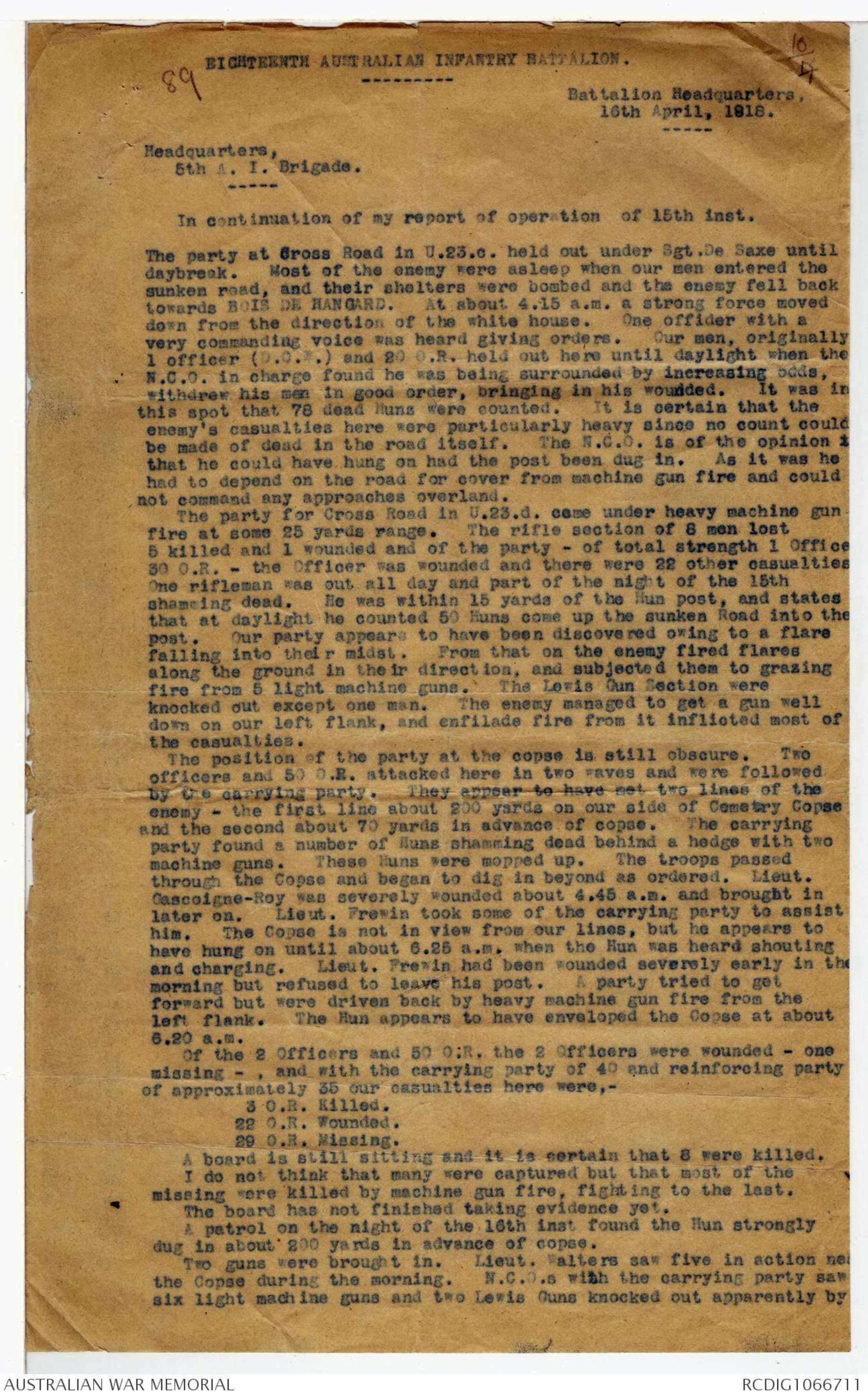

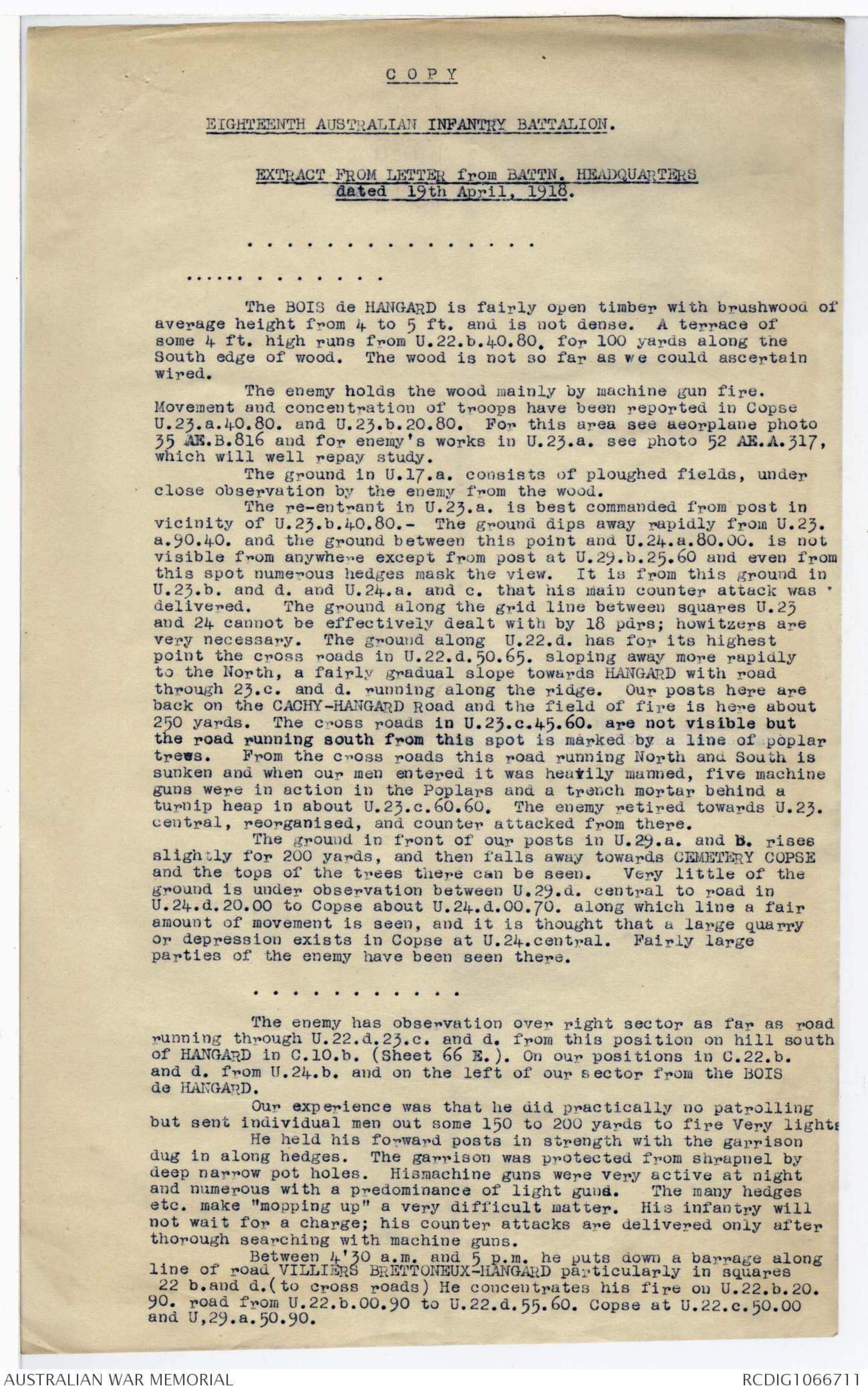
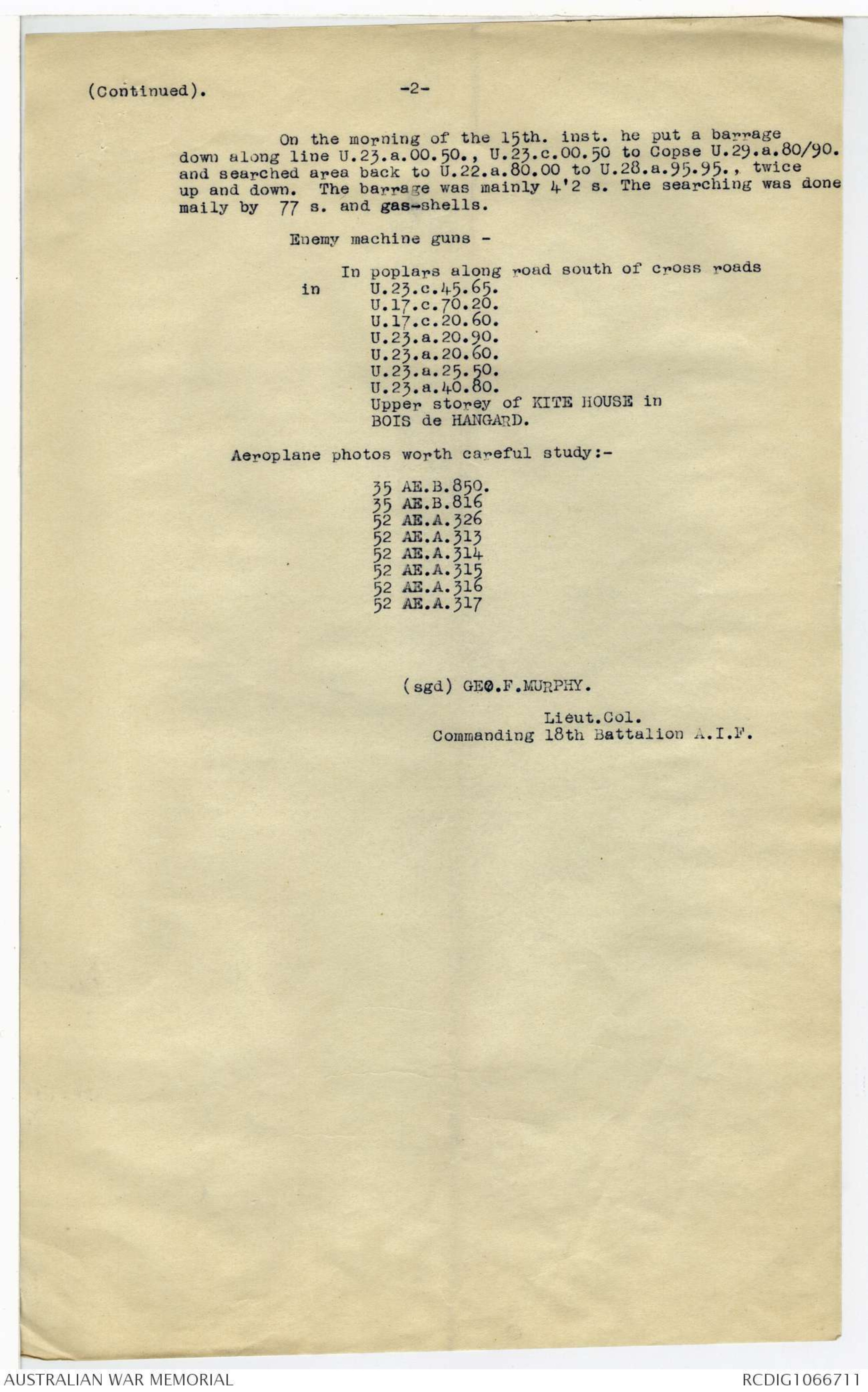
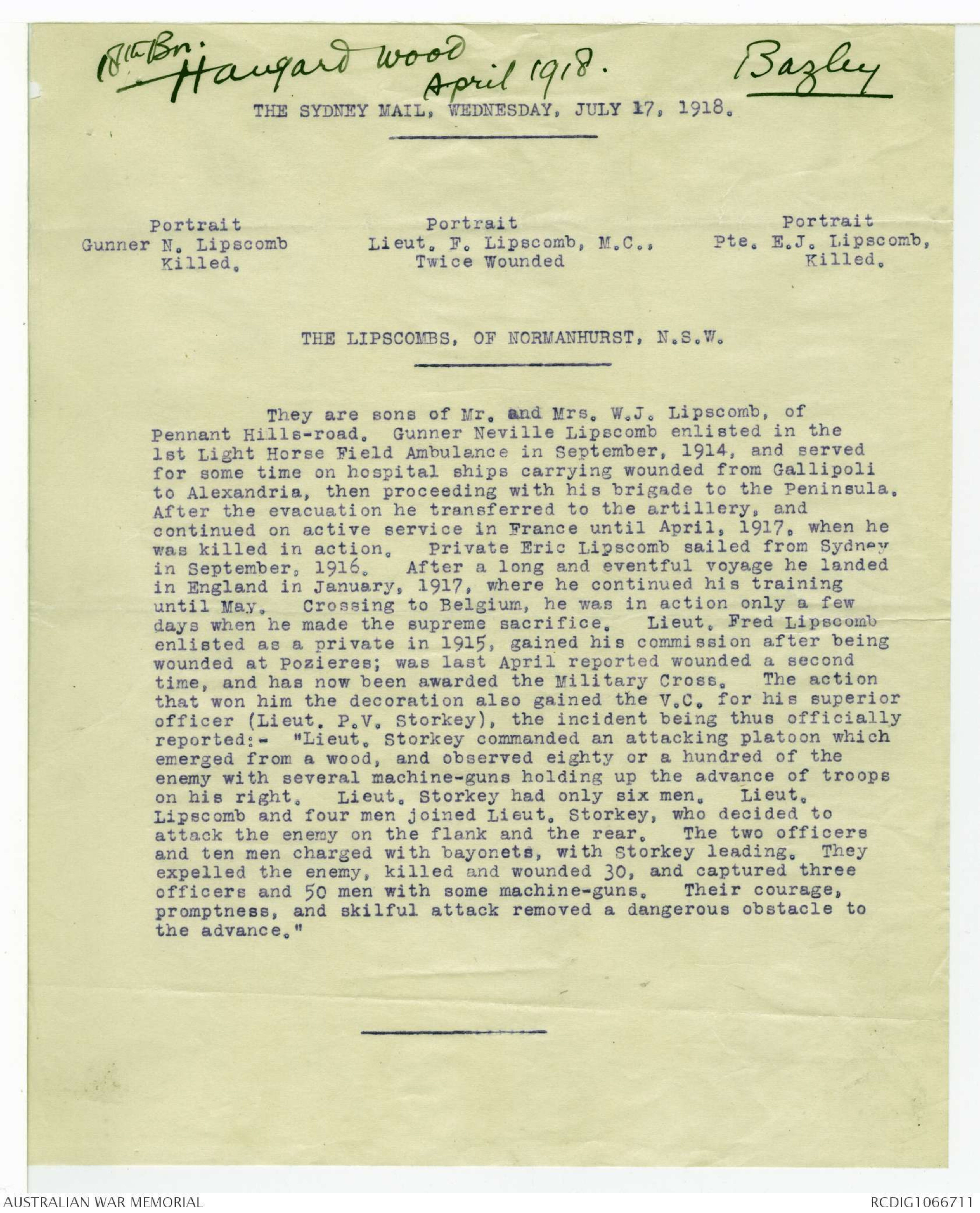

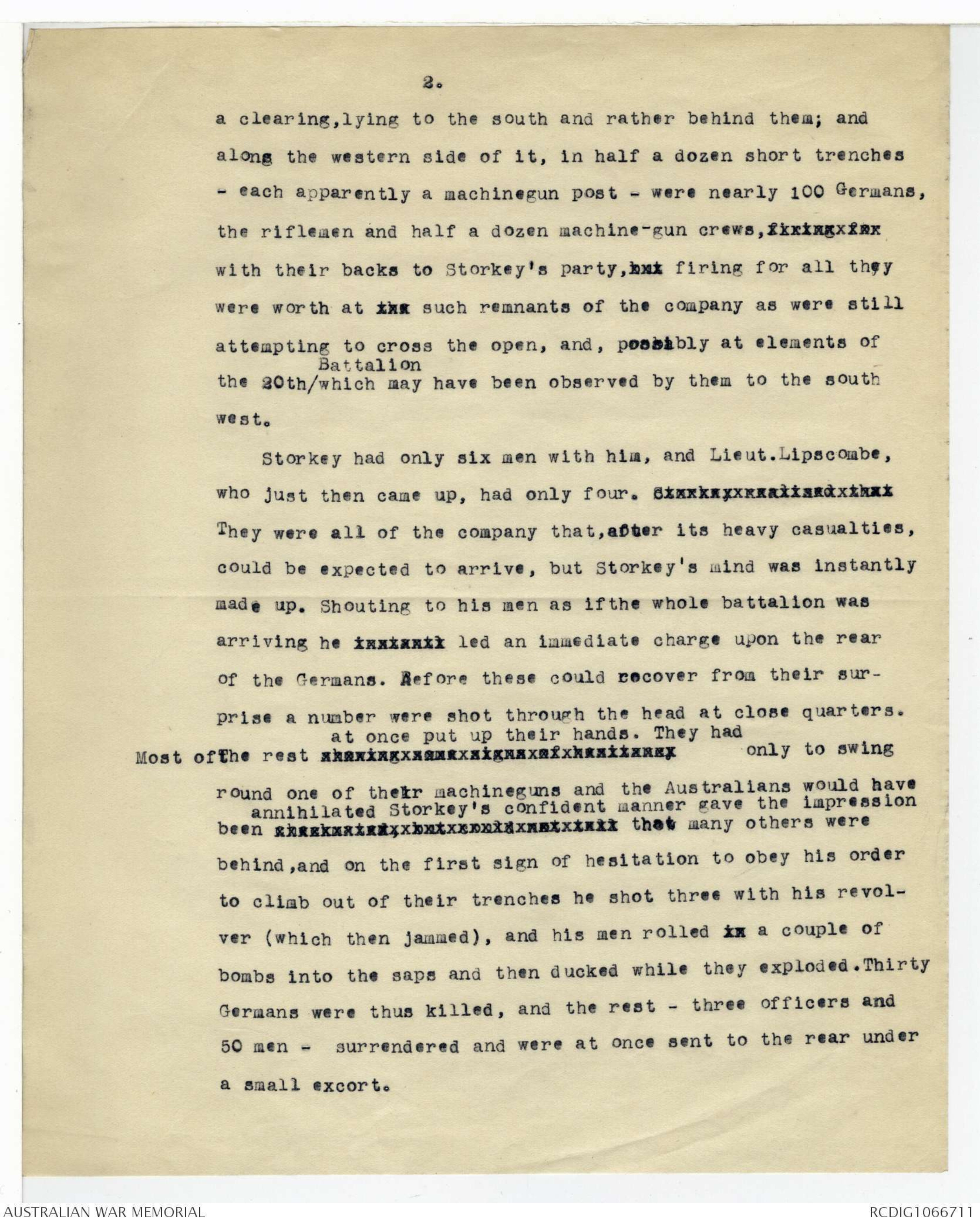
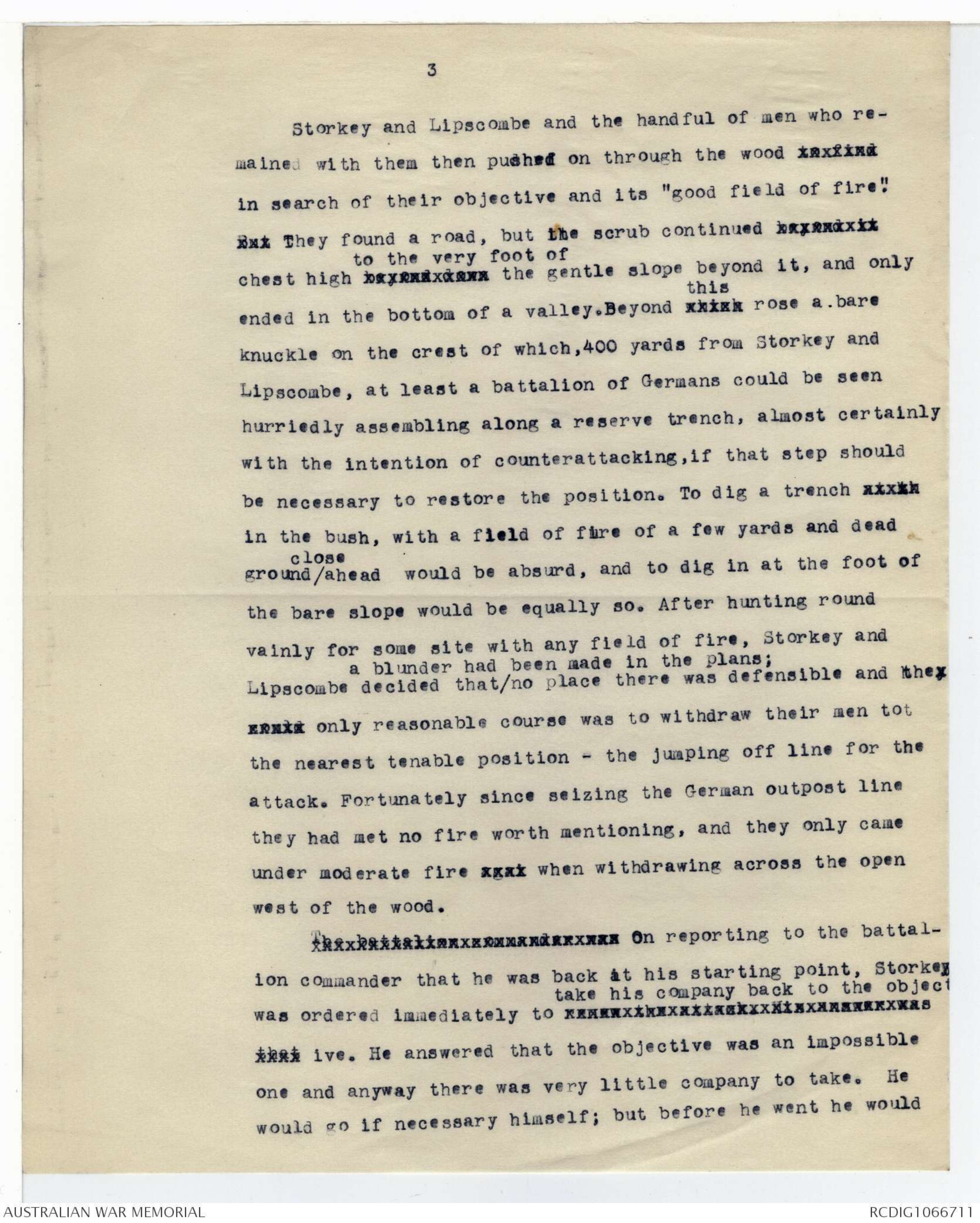

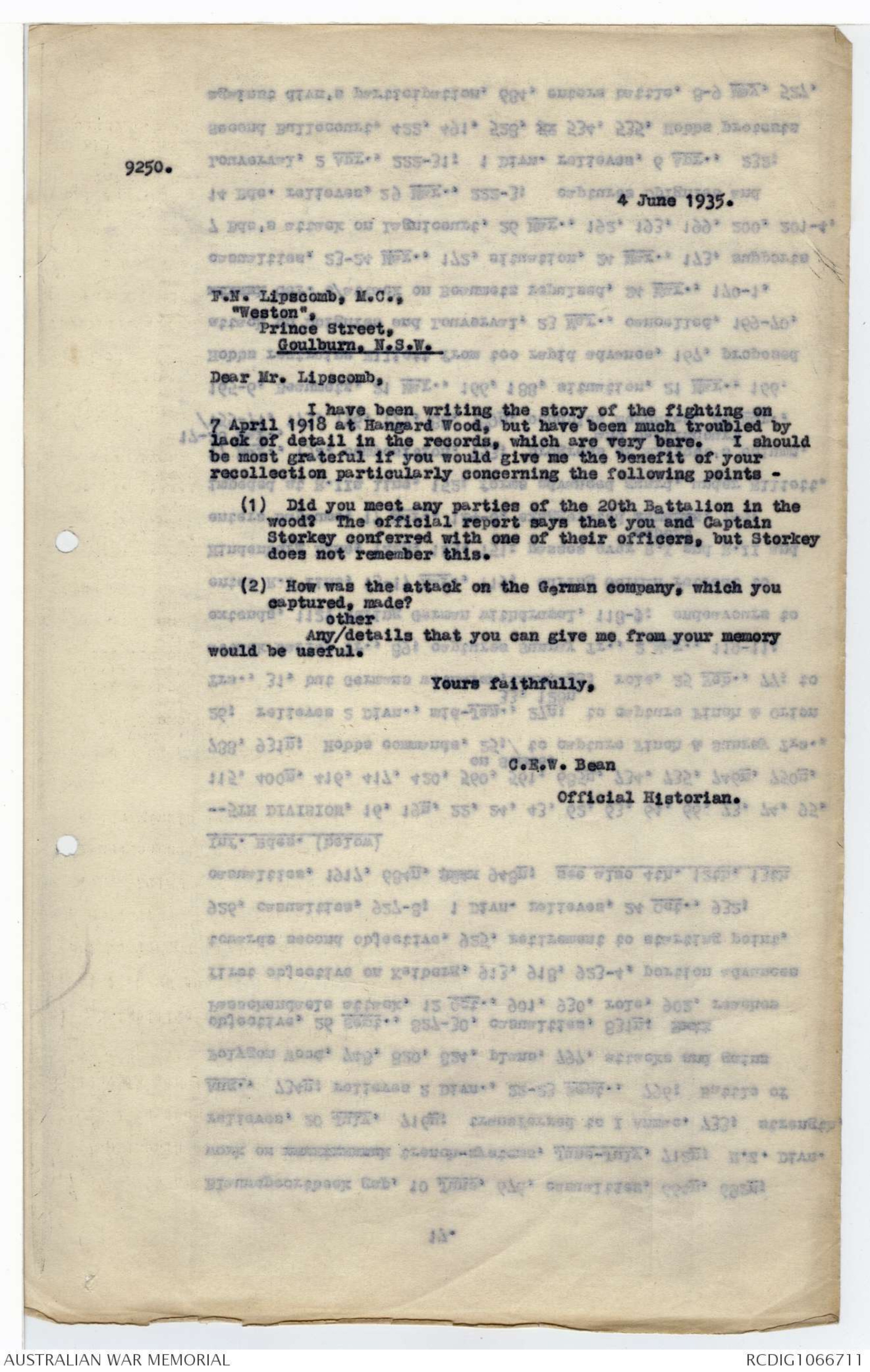
10/4
EIGHTEENTH AUSTRALIAN INFANTRY BATTALION.
89
Battalion Headquarters,
16th April, 1918.
Headquarters.
5th A. I. Brigade.
In continuation of my report of operation of 15th inst.
The party at Cross Road in U.23.c. held out under Sgt.De Saxe until
daybreak. Most of the enemy were asleep when our men entered the
sunken road, and their shelters were bombed and the enemy fell back
towards BOIS DE HANGARD. At about 4.15 a.m. a strong force moved
down from the direction of the white house. One offider with a
very commanding voice was heard giving orders. Our men, originally
1 officer (D.O.W.) and 20 O.R. held out here until daylight when the
N.C.O. in charge found he was being surrounded by increasing odds,
withdrew his men in good order, bringing in his wounded. It was in
this spot that 78 dead Huns were counted. It is certain that the
enemy's casualties here were particularly heavy since no count could
be made of dead in the road itself. The N.C.O. is of the opinion a
that he could have hung on had the post been dug in. As it was he
had to depend on the road for cover from machine gun fire and could
not command any approaches overland.
The party for Cross Road in U.23.d. came under heavy machine gun
fire at some 25 yards range. The rifle section of 8 men lost
5 killed and 1 wounded and of the party - of total strength 1 Office
30 O.R. - the Officer was wounded and there were 22 other casualties
One rifleman was out all day and part of the night of the 15th
shamming dead. He was within 15 yards of the Hun post, and states
that at daylight he counted 50 Huns come up the sunken Road into the
post. Our party appears to have been discovered owing to a flare
falling into their midst. From that on the enemy fired flares
along the ground in their direction, and subjected them to grazing
fire from 5 light machine guns. The Lewis Gun Section were
knocked out except one man. The enemy managed to get a gun well
down on our left flank, and enfilade fire from it inflicted most of
the casualties.
The position of the party at the copse is still obscure. Two
officers and 50 O.R. attacked here in two waves and were followed
by the carrying party. They appear to have met two lines of the
enemy - the first line about 200 yards on our side of Cemetry Copse
and the second about 70 yards in advance of copse. The carrying
party found a number of Huns shamming dead behind a hedge with two
machine guns. These Huns were mopped up. The troops passed
through the Copse and began to dig in beyond as ordered. Lieut.
Gascoigne-Roy was severely wounded about 4.45 a.m. and brought in
later on. Lieut. Frewin took some of the carrying party to assist
him. The Copse is not in view from our lines, but he appears to
have hung on until about 6.25 a.m, when the Hun was heard shouting
and charging. Lieut. Frewin had been wounded severely early in the
morning but refused to leave his post. A party tried to get
forward but were driven back by heavy machine gun fire from the
left flank. The Hun appears to have enveloped the Copse at about
6.20 a.m.
Of the 2 Officers and 50 O:R. the 2 Officers were wounded - one
missing - , and with the carrying party of 40 and reinforcing party
of approximately 35 our casualties here were,-
3 O.R. Killed.
22 O.R. Wounded.
29 O.R. Missing.
A board is still sitting and it is certain that 8 were killed.
I do not think that many were captured but that most of the
missing were killed by machine gun fire, fighting to the last.
The board has not finished taking evidence yet.
A patrol on the night of the 16th inst found the Hun strongly
dug in about 200 yards in advance of copse.
Two guns were brought in. Lieut. Walters saw five in action nea
the Copse during the morning. N.C.O.s with the carrying party saw
six light machine guns and two Lewis Guns knocked out apparently by
89 10/8
(2)
the Stokes Mortar bombardment. This was confirmed by Lieut.
Maxwell, M.C., D.C.M.
Our force engaged was ,-X Lieut. Thompson and 20 O.R.
X Lieut. McLaren, M.M. and 30 O.R.X Lieut. Frewin )X Lieut. Gascoigne-Roy) and 50 O.R.
Lieut. Duncan and 40 O.R. as carrying party.
In addition 35 O.R. under an officer were used for counter
attack.
Our casualties were , -
Officers X. One D.O.W. 3 Wounded (one missing).
(In addition Capt. Lowther was wounded whislt organizing
the right party.)
Other Ranks.- Three K.I.A? One D.O.W. 35 Wounded.
and 31 Missing. ( Of these 8 are now known to be K.I.A. )
The enemy losses were undoubtedly heavier for large numbers of
dead were seen.
Geo F Murphy
Lieut.-Col.
Commanding 18th Battalion, A. I. F.
C O P Y
EIGHTEENTH AUSTRALIAN INFANTRY BATTALION.
EXTRACT FROM LETTER from BATTN. HEADQUARTERS
dated 19th April, 1918.
The BOIS de HANGARD is fairly open timber with brushwood of
average height from 4 to 5 ft. and is not dense. A terrace of
some 4 ft. high runs from U.22.b.40.80, for 100 yards along the
South edge of wood. The wood is not so far as we could ascertain
wired.
The enemy holds the wood mainly by machine gun fire.
Movement and concentration of troops have been reported in Copse
U.23.a.40.80. and U.23.b.20.80. For this area see aeorplane photo
35 AE.B.816 and for enemy's works in U.23.a. see photo 52 AE.A.317,
which will well repay study.
The ground in U.17.a. consists of ploughed fields, under
close observation by the enemy from the wood.
The re-entrant in U.23.a. is best commanded from post in
vicinity of U.23.b.40.80.- The ground dips away rapidly from U.23.
a.90.40. and the ground between this point and U.24.a.80.00. is not
visible from anywhere except from post at U.29.b.25.60 and even from
this spot numerous hedges mask the view. It is from this ground in
U.23.b. and d. and U.24.a. and c. that his main counter attack was
delivered. The ground along the grid line between squares U.23
and 24 cannot be effectively dealt with by 18 pdrs; howitzers are
very necessary. The ground along U.22.d. has for its highest
point the cross roads in U.22.d.50.65. sloping away more rapidly
to the North, a fairly gradual slope towards HANGARD with road
through 23.c. and d. running along the ridge. Our posts here are
back on the CACHY-HANGARD Road and the field of fire is here about
250 yards. The cross roads in U.23.c.45.60. are not visible but
the road running south from this spot is marked by a line of poplar
trees. From the cross roads this road running North and South is
sunken and when our men entered it was heavily manned, five machine
guns were in action in the Poplars and a trench mortar behind a
turnip heap in about U.23.c.60.60. The enemy retired towards U.23.
central, reorganised, and counter attacked from there.
The ground in front of our posts in U.29.a. and b. rises
slightly for 200 yards, and then falls away towards CEMETERY COPSE
and the tops of the trees there can be seen. Very little of the
ground is under observation between U.29.d. central to road in
U.24.d.20.00 to Copse about U.24.d.00.70. along which line a fair
amount of movement is seen, and it is thought that a large quarry
or depression exists in Copse at U.24. central. Fairly large
parties of the enemy have been seen there.
The enemy has observation over right sector as far as road
running through U.22.d.23.c. and d. from this position on hill south
of HANGARD in C.10.b. (Sheet 66 E.). On our positions in C.22.b.
and d. from U.24.b. and on the left of our sector from the BOIS
de HANGARD.
Our experience was that he did practically no patrolling
but sent individual men out some 150 to 200 yards to fire Very lights
He held his forward posts in strength with the garrison
dug in along hedges. The garrison was protected from shrapnel by
deep narrow pot holes. Hismachine guns were very active at night
and numerous with a predominance of light guns. The many hedges
etc. make "mopping up" a very difficult matter. His infantry will
not wait for a charge; his counter attacks are delivered only after
thorough searching with machine guns.
Between 4'30 a.m. and 5 p.m. he puts down a barrage along
line of road VILLIERS BRETTONEUX-HANGARD particularly in squares
22 b.and d. (to cross roads) He concentrates his fire on U.22.b.20.
90. road from U.22.b.00.90 to U.22.d.55.60. Copse at U.22.c.50.00
and U,29.a.50.90.
(Continued). -2-
On the morning of the 15th. inst, he put a barrage
down along line U.23.a.00.50., U.23.c.00.50 to Copse U.29.a.80/90.
and searched area back to U.22.a.80.00 to U.28.a.95.95., twice
up and down. The barrage was mainly 4'2 s. The searching was done
maily by 77 s. and gas-shells.
Enemy machine guns -
In poplars along road south of cross roads
in U. 23.c.45.65.
U.17.c.70.20.
U.17.c.20.60.
U.23.a.20.90.
U.23.a.20.60.
U.23.a.25.50.
U.23.a.40.80.
Upper storey of KITE HOUSE in
BOIS de HANGARD.
Aeroplane photos worth careful study :-
35 AE.B.850.
35 AE.B.816
52 AE.A.326
52 AE.A.313
52 AE.A.314
52 AE.A.315
52 AS.A.316
52 AE.A.317
(sgd) GEO.F.MURPHY.
Lieut.Col.
Commanding 18th Battalion A.I.F.
[*18th Bn
Hangard Wood
April 1918. Bazley*]
THE SYDNEY MAIL, WEDNESDAY, JULY 17, 1918.
Portrait
Gunner N Lipscomb,
Killed.
Portrait
Lieut. F. Lipscomb, M.C.,
Twice Wounded
Portrait
Pte. E.J. Lipscomb,
Killed.
THE LIPSCOMBS, OF NORMANHURST, N.S.W.
They are sons of Mr. and Mrs. W.J. Lipscomb, of
Pennant Hills-road. Gunner Neville Lipscomb enlisted in the
1st Light Horse Field Ambulance in September, 1914, and served
for some time on hospital ships carrying wounded from Gallipoli
to Alexandria, then proceeding with his brigade to the Peninsula.
After the evacuation he transferred to the artillery, and
continued on active service in France until April, 1917, when he
was killed in action. Private Eric Lipscomb sailed from Sydney
in September, 1916. After a long and eventful voyage he landed
in England in January, 1917, where he continued his training
until May. Crossing to Belgium, he was in action only a few
days when he made the supreme sacrifice. Lieut. Fred Lipscomb
enlisted as a private in 1915, gained his commission after being
wounded at Pozieres; was last April reported wounded a second
time, and has now been awarded the Military Cross. The action
that won him the decoration also gained the V.C. for his superior
officer (Lieut. P.V. Storkey), the incident being thus officially
reported:- "Lieut. Storkey commanded an attacking platoon which
emerged from a wood, and observed eighty or a hundred of the
enemy with several machine-guns holding up the advance of troops
on his right. Lieut. Storkey had only six men. Lieut.
Lipscomb and four men joined Lieut. Storkey, who decided to
attack the enemy on the flank and the rear. The two officers
and ten men charged with bayonets, with Storkey leading. They
expelled the enemy, killed and wounded 30, and captured three
officers and 50 men with some machine-guns. Their courage
promptness, and skilful attack removed a dangerous obstacle to
the advance."
[*H.N.*]
19th Battalion, Hangard Wood.
From Capt. P.V. Storkie.
The officers of the attacking company were told that
the wood was lightly heald and that
on getting through the wood they would find the objective
road, with g/a good clear field of fire of 400 yards, and
They lined out/and lay down in the open just northeast of the western
wood. Storkey went to sleep, and the opening of the
barrage did not wake him. It was evident to everyone that "something
was wrong with the barrage." It was very thin and
ragged. Storkey did not wake until the his men had gone 70
yards or so, when he hurried on after them. It was just
daylight and they were had some 300 yards of open space to
cross before reaching the wood. From somewhere in the wood
on the right front came extremely heavy machinegun fire. Capt.
Wallack was hit through both knees. Lieut. McDonald was killed.
Before reaching the other side a large part of the company
had been hit. But the survivors reached the wood and xxxxxxxxx climbed
through a wire ^fence into it. It was entirely young growth, mostly about head
high, with taller saplings here and there. As Storkey, now
commanding the company, with Lieutenant Lipscombe and their
men made their way through it they were caught every now and
then by in part of the maze of six telephone lines that ^in recent fighting had
been laid through it. As they pressed on, trying to get in
rear of the force - whatever it was - that had been firing
on them when in the open, the bush thinned a little. ^After working round xxxx/ Suddenlyxxxxxxxxxxx to the xxxxx east and south they suddenly
came out on an-opening, perhaps seventyfive yards-in-length,
2.
a clearing,lying to the south and rather behind them; and
along the western side of it, in half a dozen short trenches
- each apparently a machinegun post - were nearly 100 Germans,
the riflemen and half a dozen machine-gun crews, firing for
with their backs to Storkey's party, xxx firing for all they
were worth at xxx such remnants of the company as were still
attempting to cross the open, and, possibly at elements of
the 20th ^Battalion which may have been observed by them to the south
west.
Storkey had only six men with him, and Lieut.Lipscombe,
who just then came up, had only four. xxxxxxxxxxxxxxxxx
They were all of the company that,after its heavy casualties,
could be expected to arrive, but Storkey's mind was instantly
made up. Shouting to his men as ifthe whole battalion was
arriving he xxxxxxxx led an immediate charge upon the rear
of the Germans. Before these could recover from their surprise
a number were shot through the head at close quarters.
Most of the rest xxxxxxxxxxxxxxxxxxxxxx ^at once put up their hands. They had only to swing
round one of their machineguns and the Australians would have
been xxxxxxxxxxxxxxxxxxxxxx ^annihilated Storkey's confident manner gave the impression that many others were
behind ,and on the first sign of hesitation to obey his order
to climb out of their trenches he shot three with his revolver
(which then jammed), and his men rolled xx a couple of
bombs into the saps and then ducked while they exploded.Thirty
Germans were thus killed, and the rest - three officers and
50 men - surrendered and were at once sent to the rear under
a small excort.
3
Storkey and Lipscombe and the handful of men who remained
with them then pushed on through the wood to find
in search of their objective and its "good field of fire."xxx They found a road, but the scrub continued xxxxxxxx
chest high xxxxxxxx ^to the very foot of the gentle slope beyond it, and only
ended in the bottom of a valley. Beyond xxxx ^this rose a bare
knuckle on the crest of which, 400 yards from Storkey and
Lipscombe, at least a battalion of Germans could be seen
hurriedly assembling along a reserve trench, almost certainly
with the intention of counterattacking, if that step should
be necessary to restore the position. To dig a trench xxxxx
in the bush, with a field of fire of a few yards and dead
ground ^close ahead would be absurd, and to dig in at the foot of
the bare slope would be equally so. After hunting round
vainly for some site with any field of fire, Storkey and
Lipscombe decided that ^a blunder had been made in the plans; no place there was defensible and theyxxxxxx only reasonable course was to withdraw their men tot
the nearest tenable position - the jumping off line for the
attack. Fortunately since seizing the German outpost line
they had met no fire worth mentioning, and they only came
under moderate fire xxxx when withdrawing across the open
west of the wood.xxxxxxxxxxxxxxxxxxxxxxxx On reporting to the battalion
commander that he was back at his starting point, Storkey
was ordered immediately to xxxxxxxxxxxxxxxxxxxxxxxxxxxx ^take his company back to the object xxx ive. He answered that the objective was an impossible
one and anyway there was very little company to take. He
would go if necessary himself; but before he went he would
4.
see the brigadier and make sure that he knew the conditions
at the far side of the wood. The xxxxxx ^arrival at that moment
of his fifty prisoners and their officers xxxxx gave a
more pleasant turn to the interview, and Storkey afterwards
had his interview with Brig.Gen Smith, who appreciated
his information.x
x Storkey who spent the afternoon in going forward and ^helping to bringing in
numerous of the wounded men of his company from the open in front of
the Jumling Off Line, was awarded the Victoria Cross
9250.
4 June 1935.
F.N. Lipscomb, M.C.,
"Weston",
Prince street,
Goulburn, N.S.W.
Dear Mr. Lipscomb,
I have been writing the story of the fighting on
7 April 1918 at Hangard Wood, but have been much troubled by
lack of detail in the records, which are very bare. I should
be most grateful if you would give me the benefit of your
recollection particularly concerning the following points -
(1) Did you meet any parties of the 20th Battalion in the
wood? The official report says that you and Captain
Storkey conferred with one of their officers, but Storkey
does not remember this.
(2) How was the attack on the German company, which you
captured, made?
Any ^other details that you can give me from your memory
would be useful.
Yours faithfully,
C.E.W. Bean
Official Historian.
 Beverley Pagano
Beverley PaganoThis transcription item is now locked to you for editing. To release the lock either Save your changes or Cancel.
This lock will be automatically released after 60 minutes of inactivity.